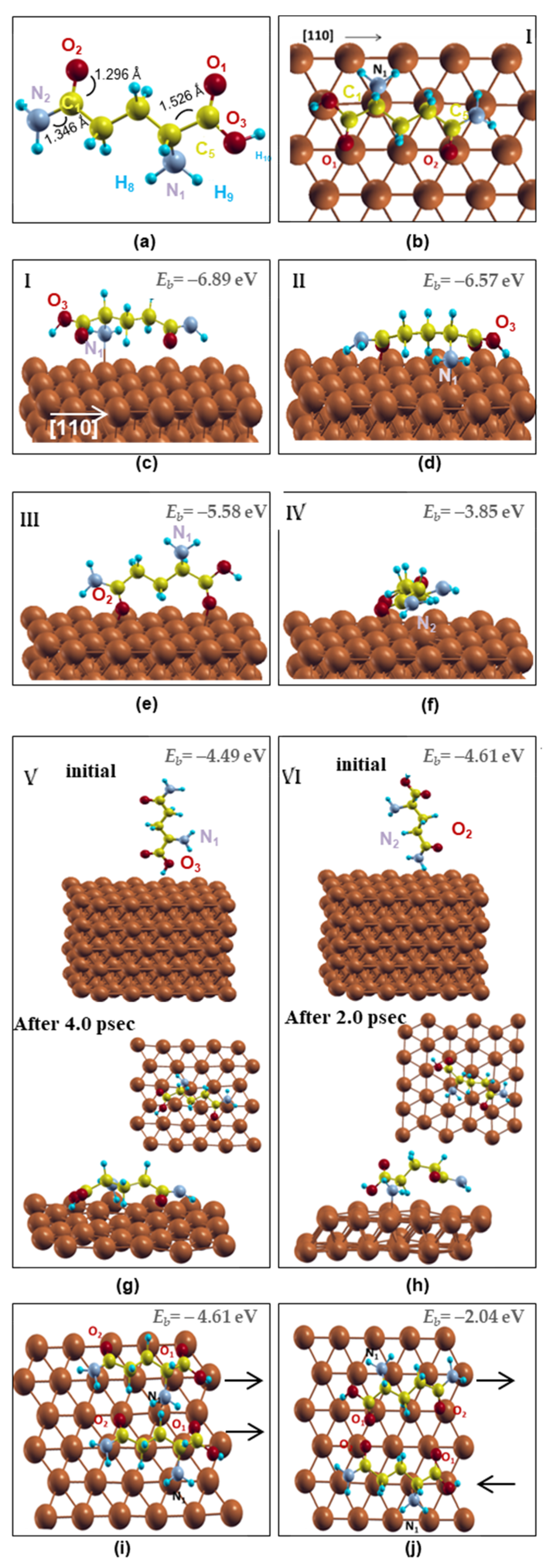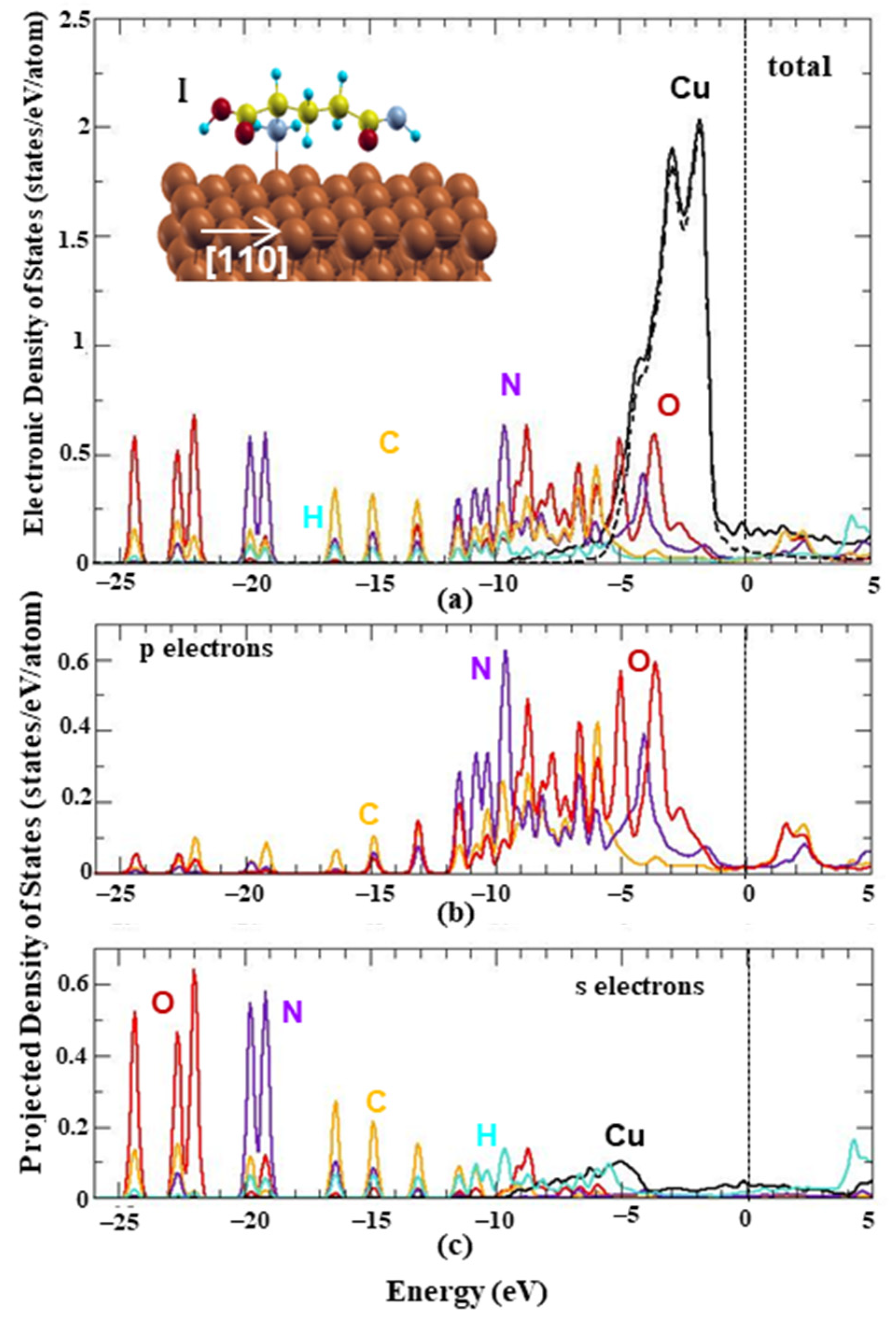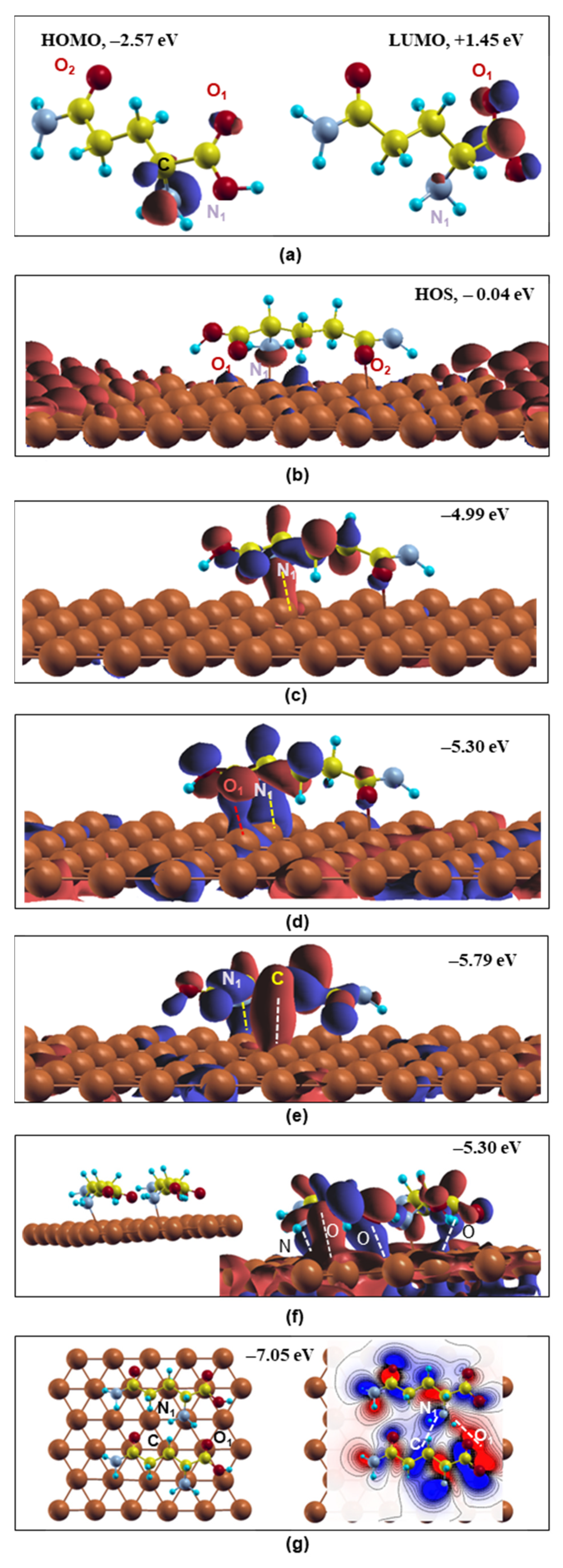L-Glutamine Coating on Antibacterial Cu Surface by Density Functional Theory
Abstract
:1. Introduction
2. Computational Details
3. Results and Discussion
3.1. Structural Properties
3.2. Electronic Properties
4. Conclusions
Author Contributions
Funding
Data Availability Statement
Conflicts of Interest
References
- Li, S.; Meng, L.; Zhu, Y.; Zhang, W.; Sun, Y.; Bai, G.; Li, X. Copper ion-loaded surface charge-convertible coatings on implant: Antibacterial and tunable cell adhesion properties. Chem. Eng. J. 2023, 478, 147439. [Google Scholar] [CrossRef]
- Wu, Y.; Zhou, H.; Zeng, Y.; Xie, H.; Ma, D.; Wang, Z.; Liang, H. Recent Advances in Copper-Doped Titanium Implants. Materials 2022, 15, 2342. [Google Scholar] [CrossRef]
- Liu, S.; Zhang, Z.; Zhang, J.; Qin, G.; Zhang, E. Construction of a TiO2/Cu2O multifunctional coating on Ti-Cu alloy and its influence on the cell compatibility and antibacterial properties Surf. Coat. Technol. 2021, 421, 127438. [Google Scholar] [CrossRef]
- Zhang, L.; Guo, J.; Huang, X.; Zhang, Y.; Han, Y. The dual function of Cu-doped TiO2 coatings on titanium for application in percutaneous implants. J. Mater. Chem. B 2016, 4, 3788. [Google Scholar] [CrossRef] [PubMed]
- Akman, A.; Alberta, L.A.; Giraldo-Osorno, P.L.; Turner, A.B.; Hantusch, M.; Palmquist, A.; Trobos, M.; Calin, M.; Gebert, A. Effect of minor gallium addition on corrosion, passivity, and antibacterial behaviour of novel b-type Ti-Nb alloys. J. Mater. Res. Technol. 2023, 25, 4110. [Google Scholar] [CrossRef]
- Alberta, L.A.; Fortouna, Y.; Vishnu, J.; Pilz, S.; Gebert, A.; Lekka, C.E.; Nielsch, K.; Calin, M. Effects of Ga on the structural, mechanical and electronic properties of β-Ti45Nb alloy by experiments and ab initio calculations. J. Mech. Behav. Biomed. Mater. 2023, 140, 105728. [Google Scholar] [CrossRef] [PubMed]
- Alberta, L.A.; Vishnu, J.; Hariharan, A.; Pilz, S.; Gebert, A.; Calin, M. Novel low modulus beta-type TieNb alloys by gallium and copper minor additions for antibacterial implant applications. J. Mater. Res. Technol. 2022, 20, 3306. [Google Scholar] [CrossRef]
- Fateh, A.; Aliofkhazraei, M.; Rezvanian, A.R. Review of corrosive environments for copper and its corrosion inhibitors Arab. J. Chem. 2020, 13, 481. [Google Scholar]
- Demadis, K.D.; Mavredaki, E.; Stathoulopoulou, A.; Neofotistou, E.; Mantzaridis, C. Industrial water systems: Problems, challenges and solutions for the process industries. Desalination 2007, 213, 38. [Google Scholar] [CrossRef]
- Dariva, C.G.; Galio, A.F. Corrosion Inhibitors—Principles, Mechanisms and Applications. In Developments in Corrosion Protection; Aliofkhazraei, M., Ed.; IntechOpen: London, UK, 2014; pp. 365–379. [Google Scholar] [CrossRef]
- Popoola, A.; Olorunniwo, O.E.; Ige, O.O. Corrosion Resistance through the Application of Anti-Corrosion. In Developments in Corrosion Protection; Aliofkhazraei, M., Ed.; IntechOpen: London, UK, 2014; pp. 241–270. [Google Scholar] [CrossRef]
- Fu, J.J.; Li, S.N.; Cao, L.H.; Wang, Y.; Yan, L.H.; Lu, L.D. L-Tryptophan as green corrosion inhibitor for low carbon steel in hydrochloric acid solution. J. Mater. Sci. 2010, 45, 979. [Google Scholar] [CrossRef]
- Obot, I.B.; Obi-Egbedi, N.O. Adsorption properties and inhibition of mild steel corrosion in sulphuric acid solution by ketoconazole: Experimental and theoretical investigation. Corros. Sci. 2010, 52, 198. [Google Scholar] [CrossRef]
- Singh, A.; Ebenso, E.E. Use of Glutamine as a New and Effective Corrosion Inhibitor for Mild Steel in 1 M HCL Solution. Int. J. Electrochem. Sci. 2013, 8, 12874. [Google Scholar] [CrossRef]
- Khaled, K.F. Corrosion control of copper in nitric acid solutions using some amino acids—A combined experimental and theoretical study. Corros. Sci. 2010, 52, 3225. [Google Scholar] [CrossRef]
- Belghiti, M.E.; Echihi, S.; Dafali, A.; Karzazi, Y.; Bakasse, M.; Elalaoui-Elabdallaoui, H.; Olasunkanmi, L.O.; Ebenso, E.E.; Tabyaoui, M. Computational simulation and statistical analysis on the relationship between corrosion inhibition efficiency and molecular structure of some hydrazine derivatives in phosphoric acid on mild steel surface. Appl. Surf. Sci. 2019, 491, 707. [Google Scholar] [CrossRef]
- Oguike, R.S.; Oni, O. Computational Simulation and Inhibitive Properties of Amino Acids for Mild Steel Corrosion: Adsorption in Gas Phase onto Fe (110). Int. J. Res. Chem. Environ. 2014, 4, 177–186. [Google Scholar]
- Kabanda, M.M.; Obot, I.B.; Ebenso, E.E. Computational Study of Some Amino Acid Derivatives as Potential Corrosion Inhibitors for Different Metal Surfaces and in Different Media. Int. J. Electrochem. Sci. 2013, 8, 10839. [Google Scholar] [CrossRef]
- Zarrouk, A.; Zarrok, H.; Salghi, R.; Hammouti, B.; Al-Deyab, S.S.; Touzani, R.; Bouachrine, M.; Warrad, I.; Hadda, T.B. A Theoretical Investigation on the Corrosion Inhibition of Copper by Quinoxaline Derivatives in Nitric Acid Solution. Int. J. Electrochem. Sci. 2012, 7, 6353. [Google Scholar] [CrossRef]
- Xia, S.; Qiu, M.; Yu, L.; Liu, F.; Zhao, H. Molecular dynamics and density functional theory study on relationship between structure of imidazoline derivatives and inhibition performance. Corros. Sci. 2008, 50, 2021. [Google Scholar] [CrossRef]
- Oguzie, E.E.; Li, Y.; Wang, S.G.; Wang, F. Understanding corrosion inhibition mechanisms—Experimental and theoretical approach. RSC Adv. 2011, 1, 866. [Google Scholar] [CrossRef]
- Zhang, D.Q.; Cai, Q.R.; Hea, X.M.; Gao, L.X.; Zhou, G.D. Inhibition effect of some amino acids on copper corrosion in HCl solution. Mater. Chem. Phys. 2008, 112, 353. [Google Scholar] [CrossRef]
- Milošev, I.; Pavlinac, A.; Hodošček, M.; Lesar, A. Amino acids as corrosion inhibitors for copper in acidic medium: Experimental and theoretical study. J. Serb. Chem. Soc. 2013, 78, 2069. [Google Scholar] [CrossRef]
- Zhao, X.Y.; Wang, H.; Yan, H.; Gai, Z.; Zhao, R.G.; Yang, W.S. Adsorption behavior of amino acids on Copper surfaces. Chin. Phys. Soc. 2001, 10, 1009. [Google Scholar]
- Zhang, Z.; Chen, S.; Feng, Y.; Ding, Y.; Zhou, J.; Jia, H. Electrochemical and molecular simulation studies on the corrosion inhibition of L-glutamine monolayers on an iron surface. J. Serb. Chem. Soc. 2009, 74, 407. [Google Scholar] [CrossRef]
- Eddy, N.O. Experimental and theoretical studies on some amino acids and their potential activity as inhibitors for the corrosion of mild steel, Part 2. J. Adv. Res. 2011, 2, 35. [Google Scholar] [CrossRef]
- Eddy, N.O. Part 3. Theoretical study on some amino acids and their potential activity as corrosion inhibitors for mild steel in HCl. Mol. Simul. 2010, 36, 354. [Google Scholar] [CrossRef]
- Jin, J.; Byun, J.K.; Choi, Y.K.; Park, K.G. Targeting glutamine metabolism as a therapeutic strategy for cancer. Nat. Exp. Mol. Medicine. 2023, 55, 706. [Google Scholar] [CrossRef]
- Maurer, R.J.; Ruiz, V.G.; Camarillo-Cisneros, J.; Liu, W.; Ferri, N.; Reuter, K.; Tkatchenko, A. Adsorption structures and energetics of molecules on metal surfaces: Bridging experiment and theory. Prog. Surf. Sci. 2016, 91, 2–72. [Google Scholar] [CrossRef]
- Artacho, E.; Sanchez-Portal, D.; Ordejon, P.; Garcia, A.; Soler, J.M. Linear-Scaling ab-initio Calculations for Large and Complex Systems. Phys. Status Solidi B 1999, 215, 809. [Google Scholar] [CrossRef]
- Perdew, J.P.; Zunger, A. Self-Interaction Correction to Density-Functional Approximations for Many-Electron Systems. Phys. Rev. B 1981, 23, 5048. [Google Scholar] [CrossRef]
- Troullier, N.; Martin, J.L. Efficient pseudopotentials for plane-wave calculations, Phys. Rev. B 1991, 43, 1993. [Google Scholar] [CrossRef]
- Junquera, J.; Paz, O.; Sanchez-Portal, D.; Artacho, E. Numerical atomic orbitals for linear-scaling calculations. Phys. Rev. B 2001, 64, 235111. [Google Scholar] [CrossRef]
- Murdock, A.T.; Koos, A.; Britton, T.B.; Houben, L.; Batten, T.; Zhang, T.; Wilkinson, A.J.; Dunin-Borkowski, R.E.; Lekka, C.E.; Grobert, N. Controlling the Orientation, Edge Geometry, and Thickness of Chemical Vapor Deposition Graphene. ACS Nano 2013, 7, 1351. [Google Scholar] [CrossRef] [PubMed]



| L-Glutamine | HOMO (eV) | LUMO (eV) | Egap (eV) |
|---|---|---|---|
| Present work | −5.74 (−1.89) | −1.72 (2.13) | 4.02 |
| DFT [16] | −5.69 | −2.11 | 3.58 |
| Quant. Chem. [26] | −5.54 | −1.66 | 3.88 |
| DFT [19] | −6.19 | 0.92 | 7.11 |
Disclaimer/Publisher’s Note: The statements, opinions and data contained in all publications are solely those of the individual author(s) and contributor(s) and not of MDPI and/or the editor(s). MDPI and/or the editor(s) disclaim responsibility for any injury to people or property resulting from any ideas, methods, instructions or products referred to in the content. |
© 2023 by the authors. Licensee MDPI, Basel, Switzerland. This article is an open access article distributed under the terms and conditions of the Creative Commons Attribution (CC BY) license (https://creativecommons.org/licenses/by/4.0/).
Share and Cite
Bouri, M.; Lekka, C. L-Glutamine Coating on Antibacterial Cu Surface by Density Functional Theory. Crystals 2023, 13, 1698. https://doi.org/10.3390/cryst13121698
Bouri M, Lekka C. L-Glutamine Coating on Antibacterial Cu Surface by Density Functional Theory. Crystals. 2023; 13(12):1698. https://doi.org/10.3390/cryst13121698
Chicago/Turabian StyleBouri, Maria, and Christina Lekka. 2023. "L-Glutamine Coating on Antibacterial Cu Surface by Density Functional Theory" Crystals 13, no. 12: 1698. https://doi.org/10.3390/cryst13121698
APA StyleBouri, M., & Lekka, C. (2023). L-Glutamine Coating on Antibacterial Cu Surface by Density Functional Theory. Crystals, 13(12), 1698. https://doi.org/10.3390/cryst13121698






